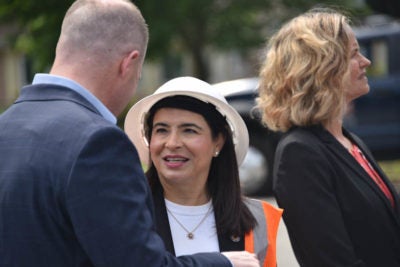
County, municipalities get more funds for road paving: More Green for the Black!


In the hallways of power in the state capitol, there are interest groups for every type of cause.
Strangely, no one advocates for the roads.
That was one revelation at a press conference called last month to tout a sharp increase in road paving funds in the fiscal year 2022 state budget. In the parking lot of St. Brigid/Our Lady of Hope School in Westbury, County Executive Laura Curran and state Senator Tim Kennedy of Buffalo were joined by Long Island Democratic senators Anna Kaplan, Kevin Thomas, James Gaughran and Todd Kaminsky.
It was Kaminsky who noted that, “In Albany, there are lots of special interests who lobby for particular funding for something. There is really no road interests. It’s up to us to battle for that,” and went on to give Kennedy—the chair of the Senate Transportation Committee—plaudits for advocating for record increases in funding.
“No matter who you are or where you live, there’s one thing that unites all New Yorkers together—we all want good roads to drive on,” Kaplan said. “We are here with good news for drivers in Nassau County as we announce record-breaking increase in road paving funds for the state. A 31 percent increase over last year. And the first increase in funding in nearly a decade. This will mean big things for our roads in every community across the county, but most importantly it will mean fewer headaches for drivers, and less wear and tear on their cars.”
Curran said, “In a world that is sometimes feeling more and more divided, there is one thing that literally unites us. And that is our roads. We all use them. We all need them. Strong infrastructure is key to our recovery from the COVID pandemic. If we can get to work if we can get things going, if we can get the economy moving again. The roads are crucial to that.”
“We all share a common denominator, and that is we all want what’s best for our communities, for our families for our children and for our future,” Kennedy said, praising the Long island delegation —including John Brooks (D–Seaford), who was not present—for working in unison for the common goal. “Because of collaboration we were able to secure a record amount of funding for Long Islanders. We secured over one-third of a billion more for roads than what was put in the executive budget, and almost $285 million more than we had just last year alone.”

After detailing more examples of funding increases he said, “This is the beautiful thing: this is the new baseline of funding that Nassau County and all the [municipalities] on Long Island are going to be receiving into the future. The businesses that have stuck it out through the tough times and are making a comeback through this pandemic, and the businesses that are making investments, it’s so important that we invest public resources into the infrastructure around those businesses. All of these funds are going to allow that to happen here in Nassau County.”
Nassau County will receive $8.2 million more this fiscal year than last year, a total of $34 million. Of that, the county government’s portion will be about $12 million.
“People want to know whether the tax dollars that they pay are actually going to a meaningful place or are being misspent,” Kaminsky pointed out. “And when their roads are not up to par, it give them a very disillusioned sense that they’re not getting the roads that they deserve. Our constituents will know that their tax dollars are making a difference and that Albany is delivering for them.”
Gaughran noted, “One of the issues we faced when [we took power as a majority as the Democratic Conference] was that for years, the roads were neglected. The state was not sending sufficient money. There was an emphasis put on mass transportation, which we also pushed and got a lot of money for. And that’s important. But for years the Senate was neglecting the fact that on Long Island people do use mass transit, but the vast majority of people have to get to places where they have to go, whether it work or gong out dining or anywhere by automobile.”
He added, “And that’s why this record amount is something we can all be proud of. And the other thing that’s so important is that we know that the money that is going here to Nassau County is going to be well spent. It’s going to be spent probably quickly and our residents are going to see real results, thanks to the leadership of our County Executive Laura Curran.”
Brooks, in a statement, said, “I am proud to have worked with Senator Kaplan and my Long Island colleagues in the state Senate to bring this much needed funding for our crumbling infrastructure. These roads are in dire shape and are desperately in need of repair. Thanks to a lot of hard work during this year’s budget process Long Island’s roadways will see the renewal we all deserve. This is how we build back better.”
Public's Not Shy
“Once roads are repaved, how long are they supposed to last until they need to be repaved again?” a reporter asked.
Nassau County Department of Public Works Commissioner Ken Arnold said the time frame was 10 to 12 years. He said the county spends about $250,000 per lane mile. Much of the state finding goes into the road paving capital plan so as to not use regular expenditures or bond the projects, creating long term debt.
“How will it be determined what roads are paved first?” Curran was asked.
“[The county] is responsible for most of the main arterial roads in the county and we have a whole phased strategy of repaving based on need,” she replied. “When I first got into office infrastructure had been neglected, that is why we’ve been so aggressive. In 2019, I believe we did 212 lane miles and we’re responsible for about 1,500 lane miles, so that’s about one-seventh of all lane miles. Last year, we did about 172 lane miles. This year, with the pandemic, I’ve asked the team to get to 150. That was the goal last year, perhaps they’ll surpass it again.”
She added, “It’s prioritized. It happens in phases. And we map it all out years and years in advance.”
In response to another question the county executive stated to laughter that the public is not shy about requesting roads to be fixed.
Added Curran, “People are confused in Nassau because we have such a confusing patchwork of municipalities. Is it a town road, is it a village road? We have a website, www.nassaucountyny.gov/myroads It’s interactive. You can click on a road and it will tell you who it belongs to and who to all if you have any issues.”
“The Long Island delegation has delivered once again,” Thomas said. “We have delivered on schools. We have delivered on taxes. And now, the third most important thing to our constituents, our roads and highways. We have brought back record funding thanks to leadership of Tim Kennedy. And great leadership from Laura Curran, who basically makes sure that the money coming in from the state is taken care of and we have a very good team in play in place to make sure this funding come through again next year.”
Kaplan said when she on the Town of North Hempstead Town Board, “We got calls and 50
percent of our job was really to make sure we go and see the roads in our town and see which roads to repave next.”
Gaughran pointed out that there were some communities in his district—which spans both counties—whose roads hadn’t been paved for 30 or 40 years or more.
“Many of these communities don’t have the money. So this is vital,” he said.
Nassau's Share
The record high investment in Nassau County’s local roads—$34 million—is allocated through the following state funded programs:
- Consolidated Local Street and Highway Improvement Program (CHIPS): $23,308,936.11 in funding for local roads and bridges, a 23.45 percent increase from the prior year, and the first increase in eight years
- PAVE NY Local Highway Aid Program: $6,469,793.24 in funding for local roads, a 50.12 percent increase from the prior year
- Extreme Winter Recovery: $4,413,015.99 in funding for local roads and bridges, a 53.85 percent increase from the prior year
Funding levels for this year will serve as a baseline for negotiations in next year’s budget, ensuring that Long Island will continue to see this high level of investment going forward.



